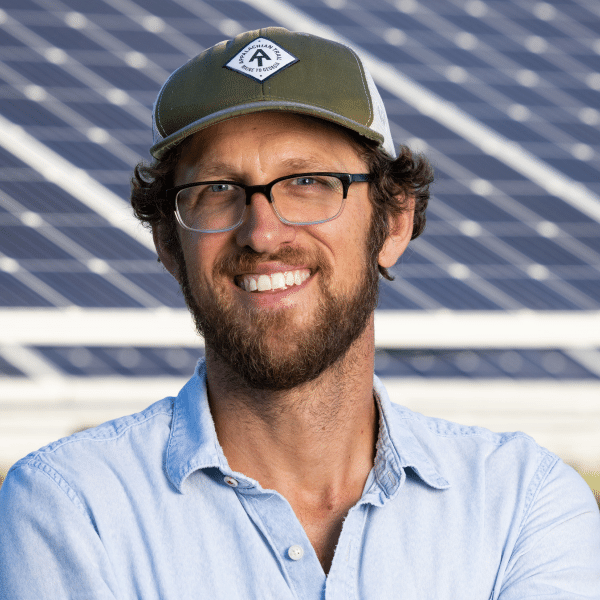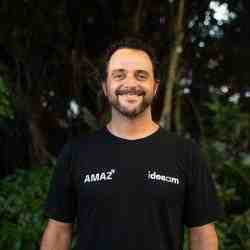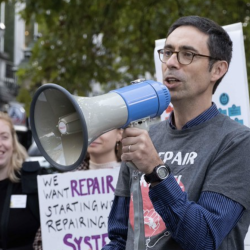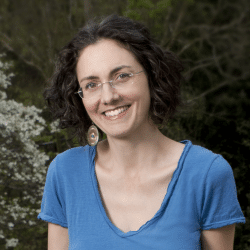Introduction
Byron is championing a better, more sustainable method of solar energy deployment via a new field called “agrivoltaics” where solar panels are co-located on workable farmland in ways that address land scarcity, climate change, and farming viability simultaneously.
The New Idea
As demand for solar energy grows exponentially, so too will demand for land on which those solar panels will be installed. The current, dominant method for doing so is right out of the fossil fuel playbook: degrade increasingly scarce farmland in order to extract energy from it. Byron is demonstrating and growing a far better alternative: design and install panels higher off the ground without degrading the land so that the farmland underneath can continue to be cultivated and tended – for farm crops of all kinds, for livestock, for pollinator ecosystems. The benefits for small-to-medium farmers are manifold, particularly as climate change and drought threatens their already tight margins and livelihoods. In fact, in the West in particular, the shade canopy from solar panels may be necessary to continue to grow a wide range of crops and raise animals given intensifying heat and dwindling rain and groundwater. Not to mention panels would enable an additional income stream by selling energy. So in that way agrivoltaics can turn vocal opponents to solar into champions at the exact moment when we need to scale solar energy production massively in the face of a rapidly warming planet.
Amidst the current rush to replace millions of acres of farmland with solar panels, Byron is urging us to consider how a small, relatively inexpensive design change – raising panels off the ground an additional four feet – can head off a race to the soil degraded bottom and preserve precious farmland for generations. Jack’s Solar Garden, his small farm outside of Boulder, Colorado, is his demonstration of how agrivoltaics works – and in 2023 was the premier site for agrivoltaics in the country at just five acres. In 2020, Byron launched the Colorado Agrivoltaics Learning Center (CALC) to be the education and replication vehicle to spread the field far and wide. Already, CALC has inspired changes to policy and tax incentives in Colorado to encourage the growth of agrivoltaics and is pushing to exempt farms co-locating solar panels from property taxes where agricultural livelihoods are fostered beneath and around the solar panels. And it’s building a national coalition of unlikely solar champions among farmers and ranchers who have been deeply skeptical of solar to date. Via these kinds of field-building strategies, the goal is to spur a national movement to prioritize agrivoltaics as a solution to the challenges of climate change, energy transition, land scarcity, and food security that fosters resilience and synergy between two vital sectors of human life – agriculture and renewable energy.
Everything CALC does rests on partnerships. It partners with local and state officials (many of whom have visited the farm) to develop smarter policies and incentives. It partners with universities in Arizona and Colorado to study the benefits to crop yield, water use, and more. And CALC is growing partnerships with land trusts across the country and citizen organizations like the American Farmland Trust and the Colorado Cattlemen and Agricultural Land Trust to grow awareness and demand for agrivoltaics over this next critical decade where enormous public dollars (from the Inflation Reduction Act and elsewhere) will accelerate solar development. Byron’s role as both social entrepreneur and land manager lends him credibility and opens doors across political lines in ways that are already manifesting in Colorado and beyond – and positions him as a natural field builder.
The Problem
The primary problem that agrivoltaics aims to solve is the growing competition for scarce land between agriculture and solar energy production. As the global demand for both food and renewable energy increases, finding sustainable ways to meet these needs becomes crucial. In the United States alone, the Department of Energy stated in 2021 that we could have upwards of 10 million acres of farmland converted to solar panels by 2050 (more than the landmass of Massachusetts and Connecticut combined). With traditional solar development techniques – with arrays installed with the expectation that they will be active for 50-75 years, the soil flattened and compacted, and plants mowed and sprayed because any growth could shade panels and reduce efficiency – that land will no longer be usable for agricultural purposes. Why does this matter? Because arable farmland is decreasing, including in the United States. Farmland in the United States decreased by 31 million acres, a territory equivalent to the state of New York, over a 30-year period, according to the American Farmland Trust. Much of that is due to development of farmland, but climate change will only exacerbate land scarcity as heat and droughts intensify. And a major push to convert agricultural land to solar production will make matters worse.
Crop yields and animal husbandry are also a concern on a warming planet. The Environmental Defense Fund estimates that crop yields in the U.S. will begin dropping as early as 2030, mostly due to an increase in “killing degree days” where temperatures become too hot for photosynthesis and crop growth. In 2023, record temperatures across the Great Plains and the American West threatened grain harvests, and the year before more than 2,000 cattle died in Kansas over a several day period due to heat stress. Meanwhile, more regular and intense droughts mean plants and animals have less water to work with – and that includes water pumped from the ground. Indeed, decades of rapid development across the Southwest are overtaxing groundwater, so much so that wells are running dry – something that Byron himself already faced on his family farm in Colorado. Already, Arizona is being forced to take 21% less water from the Colorado River, and larger cuts will be needed as the crisis deepens.
Meanwhile, the economic viability of farming is as fragile as ever, and a main reason why older generations of farmers are having difficulty finding younger farmers to carry on the work. (This is problematic too: farm consolidation is directly correlated with monoculture, biodiversity loss, and soil nutrient erosion. So it’s not just the acreage of farmland, it’s also the decrease in the number of small and medium farms that is concerning.) This is part of why farmers are (often reluctantly) selling their land to developers of various kinds. Agrivoltaics and other forms of climate adaptation can ensure that U.S. farms stay productive in the face of climate change, continuing to support global food needs as well as rural economies.
Underlying these problems are a policy and regulatory environment that is far behind the speed with which rapid solar development is happening (for example, in most places still, land can either be zoned for solar or agriculture, but not both.) As a new field, little is known about agrivoltaics and its potential, particularly in the United States (the field is more advanced in Europe and Asia.) And stubborn resistance to a clean energy transition on the political right continues to hamstring pragmatic efforts to move forward. Here Byron sees an enormous opportunity, however: to turn skepticism into bi-partisan demand (as farmers and ranchers increasingly see the writing on the wall) for better land stewardship for future generations.
The Strategy
Byron’s goal is to rapidly grow the field of agrivoltaics so that it takes root across the country as a best practice for maximizing both the productivity of our land and its stewardship. His strategy is threefold: (1) demonstrate that agrivoltaics works for farms and cattle ranches and brings a wide range of benefits, (2) raise awareness and build demand for agrivoltaics across key stakeholder groups and via national partnerships, and (3) address policy, financing and other barriers to make it easier for the field to grow quickly.
Byron’s decision to jump into agrivoltaics was initially as much personal as anything: Like countless others over the next decade who will inherit land from parents and grandparents, Byron took over his family’s hay farm in Colorado that was losing money annually and wondered what should come next. When he decided to take the creative step of co-locating solar panels with agriculture, he immediately ran into his first barrier: Boulder County (and many counties like it, it turns out) did not have a zoning ordinance for such a configuration. So Byron got to work to change that policy and hasn’t looked back.
Within two years Jack’s Solar Garden – his re-named and re-vamped family farm – was up and running, pumping renewable energy to power more than 300 homes in Boulder County, Colorado. Byron put his farm up as collateral to finance the up-front costs and quickly worked to sell his future energy production to customers in his area (his pitch was straightforward: you’d pay up front to put solar on your rooftops, pay me instead and I’ll harvest the sun’s energy for you.) That yearly income represents a consistent baseline to support basic farm operations. As a first mover, Byron was designing the playbook as he went. And one essential part of that design – and what differentiates agrivoltaics from traditional solar farms – is raising panels an additional two to four feet off the ground to enable people to work under the arrays with ease, and crops of various kinds to be cultivated.
At the same time as the solar array was being installed, Byron launched the Colorado Agrivoltaic Learning Center (CALC) to be the field catalyst and replication vehicle. Through CALC, Byron grew his partnerships with the University of Arizona and Colorado State University that had research plots at Jack’s Solar Garden studying the impacts of the solar panels on the vegetation beneath such as changes to soil moisture retention, frost resistance, and more. Very quickly they learned that for many plant varieties – from lettuce to lemon balm and other herbs to grasses for livestock – the partial shade helped them grow bigger and taste better. And importantly: require significantly less irrigation each week. CALC was key to turning Jack’s Solar Garden into a living laboratory open to the public and to key stakeholders from all sectors to learn about agrivoltaics and then champion it elsewhere. This includes small farmers like Byron, policymakers, organizations like Colorado Open Lands, The American Farmland Trust, The Nature Conservancy, The Department of Energy (DOE), the National Center for Appropriate Technology, local high school classes, and more. In fact, in the DOE’s inaugural report on agrivoltaics in the United States, Jack’s Solar Garden is referenced as a demonstration of its feasibility and potential. More than 4,000 people have visited Jack’s Solar Garden in just a few years due to CALC. No other solar array in the United States has granted so much public access.
All of this visibility feeds Byron’s second strategic pillar which is to grow awareness and build demand for agrivoltaics. This effort has many dimensions, including: (1) Collecting and sharing data about the benefits of shade to crop yield, water use, and animal stress (2) Producing basic educational materials about the field and what it entails, (3) Developing guidance documents for farmers and solar developers alike who are just getting started, (4) Presenting to legislative associations like the National Conference of State Legislatures, and (5) Informing two legislative bills in Colorado to earmark more than half a million dollars to agrivoltaics projects in the state. Next on the horizon is growing demand among cattle ranchers, experimenting with land trusts and state land boards, and spawning small agribusinesses (like rabbit and chicken farms) within existing, standard height solar arrays.
At the core of Byron’s case is that agrivoltaics represents one of those rare win-win solutions that benefits farmers and ranchers, our land and climate, and even solar developers themselves. For farmers, it’s a way to preserve millions of acres of farmland for agriculture use for future generations. It can also diversify their income and adapt their farming and ranching to a hotter, drier world. That’s because the panels act just like a tree canopy does, providing life-saving shade for plants and animals and reducing water use. CALC’s partnerships with universities provide rich data about the benefits to plants, animals, soil, and water use. Single-axis tracking solar arrays (which rotate as the sun moves across the sky) in fact support microclimates beneath them that allow different varieties of crops to thrive with different exposure to sun and shade across the day. Furthermore, agrivoltaics contributes to the overall sustainability of agriculture by promoting clean energy production and reducing the carbon footprint of farming operations. The renewable energy generated by the solar panels can be used to power on-farm equipment, reducing dependence on non-renewable sources. This not only lowers operational costs for farmers but also aligns agriculture with efforts to transition society towards green energy.
For solar developers, the main benefit is that it helps reduce resistance to solar development on farmland and in rural America full stop. The ability to continue tending to land – and preserve local ecosystems and habitats – is already paying dividends and garnering public support for solar. But there are other benefits: when small farmers or shepherds gain access to the land under panels, developers don’t have to pay for people to come spray, mow and check for equipment failure. Farmers can be first responders of sorts and reduce maintenance and monitoring costs significantly.
The creative possibilities are almost endless: For refugee families, for example, who find themselves relocated from Afghanistan to an apartment in Denver, farms like Byron’s can be a place to tend the land and grow crops for free, in exchange for weeding and monitoring the panels. Jack’s Solar Garden has become a community gathering place, hosting outdoor yoga classes, community dinners and music events, small school vegetable gardens, and more – all part of his educational outreach strategy.
As Byron and his team build demand, they’re also working on preparing the policy and regulatory environment to meet that demand. Solar developers, utility companies, local and state legislators and regulatory agencies – all have a hand in either slowing down or speeding up what’s possible. Byron has changed policy in Boulder County and works to inspire neighboring conservative counties, influenced two Colorado spending Bills and more recently a personal property tax incentive for agrivoltaics. The Colorado Department of Agriculture has now launched a grant program for agrivoltaics, and because of Byron’s efforts, national organizations like the Nature Conservancy and the American Farmland Trust are pushing solar developers to change their standard practices. He has his hands in the financing structures too, as well as engineering designs – and is encouraging a design challenge to reduce the amount of heavy steel required to install stable solar panels as high off the ground as agrivoltaics requires. He’s unlocking philanthropic and public funding alike – again at a time when solar development is ramping up significantly, fueled by climate urgency and both public and private dollars.
As he grows the field, Byron is always considering where the big levers are. One is cattle ranchers. 40 percent of all U.S. agricultural land is used for cattle, so getting cattle ranchers on board could be a boon for smart solar development that engages a community that has been largely resistant to energy transition. To them he pitches agrivoltaics as a way to help them adapt, keep their livelihoods, and secure more income over the long term. Ranchers are coming through his farm each season now, many of whom leave telling Byron he has “changed the way we look at solar.” Another moonshot idea is working with the Colorado State Land Board (whose revenues go to support Colorado’s education budget), and eventually other states, who have millions of acres of land, much of which is sub-average for hay production. But for several hundred thousand of those acres near enough to substations, agrivoltaics would increase crop yields and generate $400-800 per acre per year instead of the $4 per acre cattle ranchers pay the state to graze the land. Imagine what that could do for the state’s education budget, wonders Byron, and how building solar panels high enough for cattle grazing beneath could support the cattle ranching families.
Informed by Byron’s leadership, major federal agencies like the USDA and the DOE are putting tens of millions into agrivoltaics projects in Colorado, Illinois, Arizona and beyond. The potential is enormous: Co-developing land for both solar photovoltaic power and agriculture could provide 20% of total electricity generation in the United States with an investment of less than 1% of the annual U.S. budget, according to Oregon State University researchers. Because of Byron’s leadership, the Nature Conservancy is now highlighting agrivoltaics as a solution to cost-effectively deliver clean energy solutions while minimizing land use and impacts on biodiversity.
The Colorado Agrivoltaics Learning Center is still small – with just a team of four and a 2023 budget of $200,000. And yet they’ve just received a second major grant from the Walton Family Foundation and are growing their fee-for-service work with developers. The level of visibility and impact they’ve had despite their size is a testament to their scrappy ability to find the key levers and pull them.
The Person
Byron grew up as the odd one out in a family of introverted engineers who mostly kept to themselves. He was in the 5th grade when he asked his mother if they could go see the Vikings. Wanting to encourage his desire to learn about the wider world, she planned a trip to Denmark, Sweden and Norway to “find the Vikings”, despite having traveled very little internationally in her life. Byron continued to independently seek answers and wisdom from other cultures and developed a deep reverence for the natural world as a boy scout. Always motivated to help people, Byron decided to major in biomedical engineering during college, but eventually realized that whatever he designed would only be accessible to 0.1% of the population, so he decided to pursue teaching instead. Two weeks after he graduated, he was on a plane to Cameroon as a Peace Corps Volunteer. Those two years were the most difficult and formative years of his life – they taught him how to engage with other cultures, including the limitations of being a perpetual outsider doing social change work, as well as the preciousness of life after many close encounters with death. They also reinforced his deep belief that we all have a responsibility to leave a place better than we found it, and that the best risks are those for whom the rewards benefit all.
Byron’s engineering skills, leadership, and adaptability took him all over the world -- working on bio-sand filters in Ghana for the University of North Carolina, a rural clinic in Ethiopia for Doctors Without Borders, or responding to the cholera outbreak in Haiti a year after the earthquake in 2009. In 2011, Byron found his stride as a diplomat focusing on natural resource manager at the US Agency for Internatioanl Development (USAID). Notably, he championed an effort to unlock startup funding to an organization to protect over 2 million hectares of forest in eastern Zambia, which ended up being BioCarbon Partners (BCP). After years of work beyond his time with USAID, BCP secured 100 million euros from a German bank to provide them with carbon offsets for BCP’s measured and verified protection of all that forest – a major conservation victory that he spearheaded, and that he attributes to a growing entrepreneurial confidence. When he felt that it was time for a change, he headed back to the US to consider his next chapter.
Upon returning home in 2016, Byron decided to take six months to hike the Appalachian trail from Georgia to Maine. After spending so many years abroad, he was moved by seeing another version of America that now felt foreign – Appalachian towns like the one where he’d grown up were visibly ravaged by a lack of jobs and the opioid crisis. He recalls spotting confederate flags all the way up to Maine during Trump’s election year. Upon completing his hike, he decided to move to Colorado and figure out a new life on his family’s farm.
Byron recalls two early influences that have shaped his outlook and his idea for agrivoltaics: The first were the Boy Scouts and the deeply engrained lesson of “leave no trace.” The second is a Cameroonian indigenous chief that told him that societies really only have people and land, and it’s our responsibility to make sure that neither are neglected. Byron’s guiding philosophy is that when you care for the land first, you open up all kinds of opportunities for communities, livelihoods, and sustainability for future generations.




